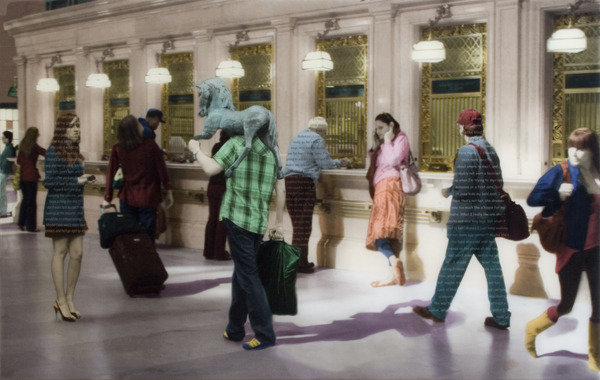Sherry Karver / Kathryn Siegler
dal 1/5/2013 al 7/6/2013
Segnalato da
1/5/2013
Sherry Karver / Kathryn Siegler
Kim Foster Gallery, New York
Karver's work speaks directly to this uniquely post-post-modern alienation. Siegler's acute observation transform discarded objects of the past, imbuing them with meaning and substance for a contemporary viewer.

At a time in human history when our inter-connectivity, our ability to communicate with (or at least to) one another, has reached both globe-girdling and sub-atomically intimate levels, we can feel almost as if we are privy to one another's most guarded secrets, regardless who one another may be. We seem to "know" the new guy in the news, the face on Facebook, the tweeter from the tweet, and the only thing left separating us is language. Such a sense of inter-omniscience is balanced - well, countermanded - by its flip side, the suspicion that our fellow homo sapiens are in fact impossibly opaque, and that what we actually are accessing is not their personalities but their personas, characters constructed, carefully or casually, doing their best to engage us in an ongoing psychological cosplay. We never feel truly alone, and we never feel truly acquainted.
Sherry Karver's work speaks directly to, and plays with, this uniquely post-post-modern alienation, an alienation born of just the right amount of too much information. It sets us adrift among our peers, imagining for us who they are, who they are trying to be, and why they happen to be where they are at that moment, dressed as they are, poised as they are, acting as they are. Sometimes (notably in the light box editions) the faces in the crowd project no voice and break up in a stream of pixels, their presence in our visual space as fleeting as a dream and as detail-poor as a cellphone capture, their image yet naggingly persistent. Other times, the slump or stride of a body proposes an entire short story, generating a fractured disquisition Karver identifies, describes, and provides with the coherence of a novelist "discovering" a character or a director filling out an establishing shot.
Karver's media are photography and painting, but her method is literary - never more so than when she interjects figures from the past into the present, highlighting this trope of memory with filmic gloss in order to allow us more familiar, comfortable transition. Our ready access to the past, after all, is as peculiar to our time as is our access to one another. We are habituated to the cinematic literalization of our imagination, to watching time and space conflate, times and spaces fuse before our very eyes. Karver exploits this (originally) modernist sense of the cumulative present - and especially our unwitting dependence on it - and in her work finds the point at which social media (an oddly neo-modernist phenomenon) set us adrift in our own movies...
Excerpt from catalog essay by Peter Frank, March 2013
----
Kathryn Siegler's acute observation, laser focus, and healthy appreciation of irony, illuminate and transform discarded objects of the past, imbuing them with meaning and substance for a contemporary viewer. Classic black and white films, typography, vintage packaging and neon signs combine to form her muse. Though Kathryn Siegler is a painter with a thoroughly modern American perspective, much of the artist's imagery focuses on subjects that invoke the past.
"I use what seem to be innocent vintage objects to send contemporary, sometimes ironic, societal messages. I appreciate the quality of the packaging and the artistry of design in these everyday objects and signs, the humor and wit in the product names and copy, all of which were meant to be consumed and discarded. But when the objects are isolated and showcased, people see them in a completely different light and they take on whole new meanings, multiple meanings, and manipulated meanings. My mission is to seduce viewers with the details and create a visual dialogue with my work."
With a deft hand, Siegler employs transparent paint layers to achieve the luminosity in her work. She creates mood, depth, and meticulous details which give her objects their unique identity. Like the many layers in her paint, she also employs layers of meaning in the objects that she chooses. The multifaceted text found within these subjects, combined with dramatic light and shadow, serve to communicate her seductive, thought provoking, skillfully composed paintings.
Reception: Thursday, May 2nd, 6 to 8 pm
Kim Foster Gallery
529 West 20th Street, New York
Hours: Tuesday through Saturday 11am to 6pm
Free Admission



